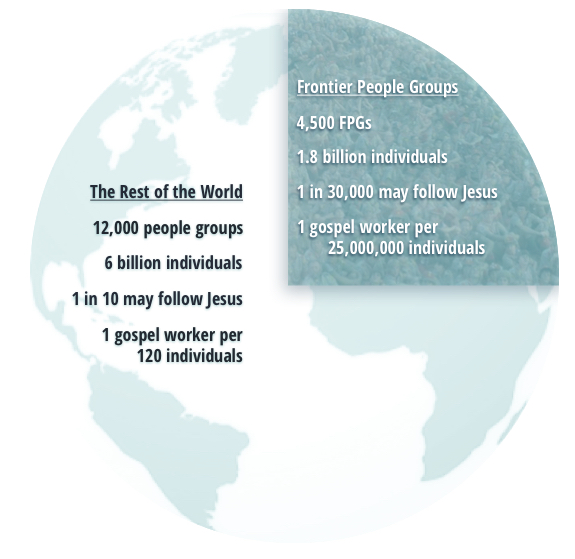The Great INJUSTICE

Where Will You Help?
The Distribution of Gospel Workers from Outside their own People
lives or works among Frontier Unreached People Groups (FPGs), where:
- It is believed Jesus is only for “Christian” peoples, and one must leave their people to follow Jesus.
- The gospel has had no visible impact.
- On average only 1 in 10,000 even identifies with Jesus.
- Less than 1 in 1,000 (0.1%) identify with Jesus at all.
- No sustained Jesus movement.
These FPGs have few if any believing households.
For every worker from the outside among all of FPGs, there is a global average of 450,000 who don’t identify with Jesus in any way.
live or work in other Unreached People Groups (UPGs) that have been more responsive, where:
- Enough identify with Jesus that following Jesus is a recognized people for their people.
- the gospel has begun to have an impact.
In mission strategy, all UPGs are defined as:
- Less than 1 in 50 are estimated to follow Jesus AND
- Less than 1 in 20 identify with Jesus at all.
These other, more receptive UPGs have strong enough communities of believing households to advocate for the needs and opportunities among their people, and to assist workers from the outside.
For every worker from the outside among all UPGs, there is a global average of 150,000 who don’t identify with Jesus in any way.
live or work in “Reached” People Groups, where:
- on average globally, half identify as Christian,
- the gospel has had visible impact,
- many openly follow Jesus.
In mission strategy, “Reached” People Groups are defined as:
- More than 1 in 50 estimated to follow Jesus, OR
- More than 1 in 20 identify with Jesus at all.
There is still much work to do even among these “Reached” People Groups, and plenty of people who don’t identify with Jesus in any way.
For every worker from the outside among all “Reached” People Groups, there is a global average of 5,000 who don’t identify with Jesus in any way.
Frontier People Groups Compared to the Rest of the World

Frontier People Groups
1,800,000,000 (1.8 billion) people live in about 4,500 Frontier People Groups (FPGs).
An estimated 60,000 Jesus-followers (1 in 30,000) live among 200,000 that identify with Jesus in some way (1 in 10,000).
These groups receive an estimated 4,000 workers from outside their people group, plus an estimated 4,000 local workers among all who identify with Jesus. That’s a total of one worker (local and from the outside) for every 220,000 who don’t identify with Jesus.
In these groups the spread of the gospel lags far behind population growth.
The Rest of the World
6,000,000,000 (6 billion) live in 12,000 other people groups where the gospel has taken root to varying degrees.
Here, 2.5 billion identify with Jesus in some way (3 in 7), with an estimated 600,000,000 (600 million) Jesus-followers (1 in 10).
An estimated 50,000,000 local workers in these groups are joined by an additional 400,000 cross-cultural workers. That’s one worker (local and from the outside) for every 70 people who don't identify with Jesus.
In these groups, on average, the gospel spreads much faster than population growth until some form of saturation occurs.
The Thirty-One FPGs
The thirty-one Frontier People Groups in this prayer guide encompass 900 million people, 10% of the world’s population and 50% of all the world’s Frontier People Groups.
Why the Disparity?
There are many reasons an estimated 96% of workers from outside end up among “Reached” People Groups:
- Plenty of people still don’t follow Jesus
- Believers elsewhere have more direct contact—through tourism, business and family connections, etc.—where the gospel has had more impact. This makes more believers conscious of the needs and opportunities in other “Reached” People Groups.
- The long-term influence of the gospel in “Reached” People Groups has improved living conditions so that life and ministry isn’t so difficult for the worker.
- The gospel has introduced cultural similarities that make life and ministry easier and more enjoyable in most “Reached” People Groups.
Similarly, missionaries and ministries to unreached people groups have many legitimate reasons for favoring a receptive UPG (where a community of believers is already growing). Among receptive UPGs:
- The community of believers becomes an advocate for the needs and opportunities among their people.
(FPGs don’t have this internal advocate.) - The community of believers offers the missionary fellowship, logistical support and language help.
(Missionaries to FPGs have to work this out all on their own.) - Missionaries to more receptive UPGs can fill a wider variety of useful roles.
(Those working among FPGs need to focus on pioneer work—starting the first contagious communities of believing households.) - Missionaries to more receptive UPGs are more likely to be able to report rapid “fruit” and “progress” to their sending base.
(Pioneer mission work generally takes longer to produce visible fruit.)
